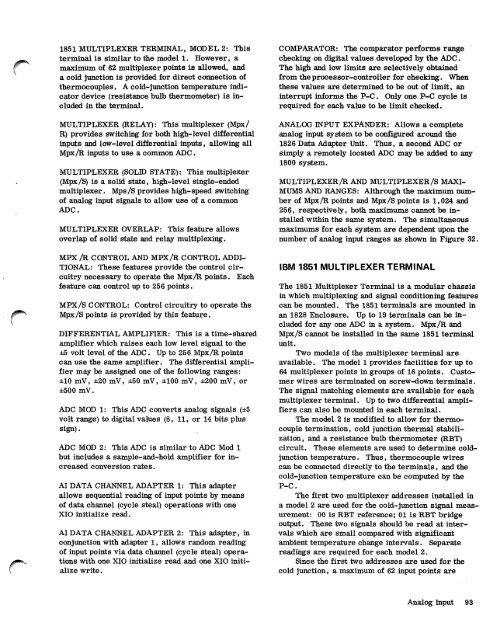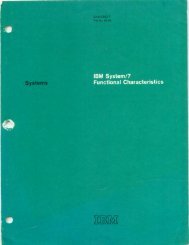Systems Reference Library - All about the IBM 1130 Computing ...
Systems Reference Library - All about the IBM 1130 Computing ...
Systems Reference Library - All about the IBM 1130 Computing ...
- No tags were found...
You also want an ePaper? Increase the reach of your titles
YUMPU automatically turns print PDFs into web optimized ePapers that Google loves.
1851 MULTIPLEXER TERMINAL, MODEL 2: Thisterminal is similar to <strong>the</strong> model 1. However, amaximum of 62 multiplexer points is allowed, anda cold junction is provided for direct connection of<strong>the</strong>rmocouples. A cold-junction temperature indicatordevice (resistance bulb <strong>the</strong>rmometer) is includedin <strong>the</strong> terminal.MULTIPLEXER (RELAY): This multiplexer (Mpx/R) provides switching for both high-level differentialinputs and low-level differential inputs, allowing allMpx/R inputs to use a common ADC.MULTIPLEXER (SOLID STATE): This multiplexer(Mpx/S) is a solid state, high-level single-endedmultiplexer. Mps/S provides high-speed switchingof analog input signals to allow use of a commonADC.MULTIPLEXER OVERLAP: This feature allowsoverlap of solid state and relay multiplexing.MPX /R CONTROL AND MPX/R CONTROL ADDI-TIONAL: These features provide <strong>the</strong> control circuitrynecessary to operate <strong>the</strong> Mpx/R points. Eachfeature can control up to 256 points.MPX/S CONTROL: Control circuitry to operate <strong>the</strong>Mpx/S points is provided by this feature.DIFFERENTIAL AMPLIFIER: This is a time-sharedamplifier which raises each low level signal to <strong>the</strong>volt level of <strong>the</strong> ADC. Up to 256 Mpx/R pointscan use <strong>the</strong> same amplifier. The differential amplifiermay be assigned one of <strong>the</strong> following ranges:±10 mV, ±20 mV, 150 mV, 1100 mV, ±200 mV, or±500 mV.ADC MOD 1: This ADC converts analog signals (±5volt range) to digital values (8, 11, or 14 bits plussign).ADC MOD 2: This ADC is similar to ADC Mod 1but includes a sample-and-hold amplifier for increasedconversion rates.AI DATA CHANNEL ADAPTER 1: This adapterallows sequential reading of input points by meansof data channel (cycle steal) operations with oneXIO initialize read.AI DATA CHANNEL ADAPTER 2: This adapter, inconjunction with adapter 1, allows random readingof input points via data channel (cycle steal) operationswith one XIO initialize read and one XIO initializewrite.COMPARATOR: The comparator performs rangechecking on digital values developed by <strong>the</strong> ADC.The high and low limits are selectively obtainedfrom <strong>the</strong> processor-controller for checking. When<strong>the</strong>se values are determined to be out of limit, aninterrupt informs <strong>the</strong> P-C. Only one P-C cycle isrequired for each value to be limit checked.ANALOG INPUT EXPANDER: <strong>All</strong>ows a completeanalog input system to be configured around <strong>the</strong>1826 Data Adapter Unit. Thus, a second ADC orsimply a remotely located ADC may be added to any1800 system.MULTIPLEXER/R AND MULTIPLEXER/S MAXI-MUMS AND RANGES: Althrough <strong>the</strong> maximum numberof Mpx/R points and Mpx/S points is 1,024 and256, respectively, both maximums cannot be installedwithin <strong>the</strong> same system. The simultaneousmaximums for each system are dependent upon <strong>the</strong>number of analog input ranges as shown in Figure 32.<strong>IBM</strong> 1851 MULTIPLEXER TERMINALThe 1851 Multiplexer Terminal is a modular chassisin which multiplexing and signal conditioning featurescan be mounted. The 1851 terminals are mounted inan 1828 Enclosure. Up to 19 terminals can be includedfor any one ADC in a system. Mpx/R andMpx/S cannot be installed in <strong>the</strong> same 1851 terminalunit.Two models of <strong>the</strong> multiplexer terminal areavailable. The model 1 provides facilities for up to64 multiplexer points in groups of 16 points. Customerwires are terminated on screw-down terminals.The signal matching elements are available for eachmultiplexer terminal. Up to two differential amplifierscan also be mounted in each terminal.The model 2 is modified to allow for <strong>the</strong>rmocoupletermination, cold junction <strong>the</strong>rmal stabilization,and a resistance bulb <strong>the</strong>rmometer (RBT)circuit. These elements are used to determine coldjunctiontemperature. Thus, <strong>the</strong>rmocouple wirescan be connected directly to <strong>the</strong> terminals, and <strong>the</strong>cold-junction temperature can be computed by <strong>the</strong>P-C.The first two multiplexer addresses installed ina model 2 are used for <strong>the</strong> cold-junction signal measurement:00 is RBT reference; 01 is RBT bridgeoutput. These two signals should be read at intervalswhich are small compared with significantambient temperature change intervals. Separatereadings are required for each model 2.Since <strong>the</strong> first two addresses are used for <strong>the</strong>cold junction, a maximum of 62 input points areAnalog Input 93
















